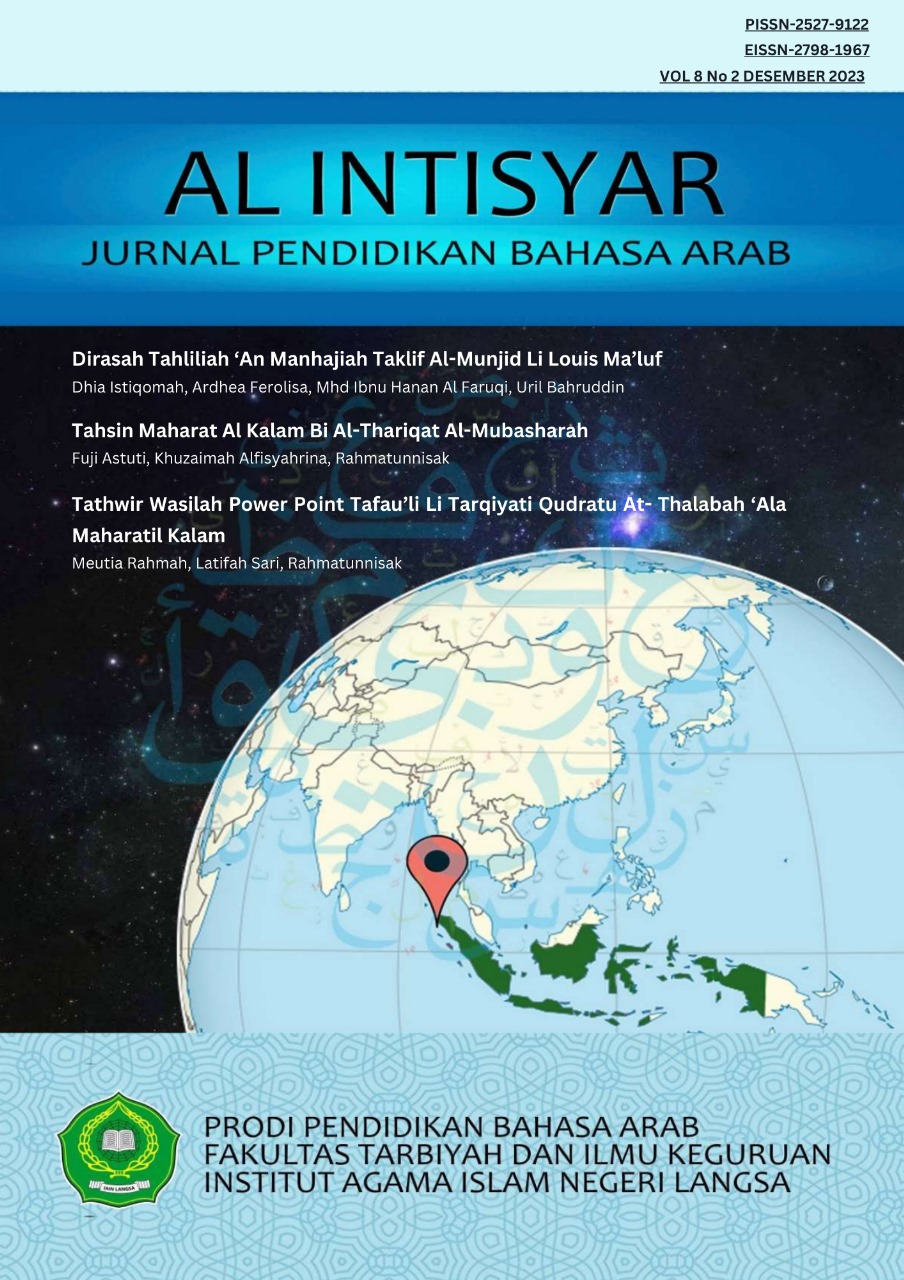Main Article Content
Abstract
The causes of difficulties in Arabic are ignorance of the rules or customs of the language, the influence of the mother tongue, and inaccurate language teaching. This study aims to identify vocal errors in the use of pauses in Arabic by semester I students majoring in Arabic language education at Islamic University Ali bin Abi Thalib Surabaya. The method used is a qualitative one, namely descriptive analysis, which explains the data and summarizes it in words. Data collection techniques were carried out using free listening and speaking techniques, writing techniques, and recording techniques using a voice recorder. The results of this study indicate that there are three mistakes that are often made by students when using pauses in Arabic, namely that first, students read texts with pauses but do not read in a high tone before pauses (52.4%). Second, students read the text with pauses but not at the proper pauses (33.3%). Third, there was no pause at all in students' pronunciation while reading the text (14.3%). The results of this study provide an overview of phonological errors in the use of pauses in Arabic so that they can be used as a reference for evaluation in learning Arabic.
Keywords
Article Details
References
- 1. المراجع العربية
- الله, ع. ا. ع. (2000). تØليل الأخطاء اللغوية الكتابية لدى طلاب معهد الخرطوم الدولي للغة العربية الناطقين باللغات الأخرى. جامعة الدول العربية.
- النساء, Ø£. Ø®. (2021). تØليل الأخطاء الصوتية ÙÙŠ مهارة القراءة لدى طلّاب الÙصل الرابع ÙÙŠ مدرسة طلب الدين الابتدائية غندوساري بليتار (جامعة مولانا مالك إبراهيم الإسلّمية الØكومية مالانج). جامعة مولانا مالك إبراهيم الإسلّمية الØكومية مالانج. Retrieved from http://etheses.uin-malang.ac.id/32153/
- بروان, د. (1994). أسس تعلّم اللغة وتعليمها: ترجمة عبده الراجØÙ‰ وعلى أجمد شعبان. بيروت: دار النهضة العربية.
- خلÙ, ع. (1994). اللغة والبØØ« اللغوي. القاهرة: مكتبة الأدب.
- داوود, Ù…. (2018). العربية وعلم اللغة الØديث. سيعا ساري: مكتبة لسان عربي.
- رشيد, ع. ا. (2010). علم الأصوات النطقي نظرية ومقارنة مع تطبيق ÙÙŠ القرآن الكريم. مطبعة الجامعة مولانا مالك إبراهيم الإسلامية الØكومية بامالانج.
- شاهين, ت. م. (1980). علم اللغة العام. القاهرة: دار التضامن.
- صيني, س. Ø¥. (1994). قواعد أساسية ÙÙŠ البØØ« العلمي. سوريا: مؤسسة الرسالة.
- طعيمة, ر. Ø£. (1989). تعليم العربية لغير الناطقين بها مناهجه وأساليبه. منسورات المنظمة الأسلامية للتربية والعلوم والثقاÙØ©.
- عمر Ø£Øمد مختار. (1991). دراسة الصوت اللغوي. القاهرة: عالم الكتب.
- Ùرايوغو, Ù. (2020). تØليل الأخطاء الصوتية ÙÙŠ مهارة القراءة لدى طلاب معهد الأئمة العالي مرجوساري مالانج. Retrieved from http://etheses.uin-malang.ac.id/16165/
- كمال إبراهيم بدري. (1982). علم اللغة المبرمج: الأصوات والنظام الصوتي مطبقا على اللغة العربية. عمادة شؤون المكتبات، جامعة الملك سعود.
- كمال البشر. (2000). علم الأصوات. القاهرة: دار غريب للطباعة والنشر والتوزيع.
- مأÙأست, Ø£. (2018). تØليل الأخطاء الصوتية ÙÙŠ قراءة القرآن عند طلاب تايلاند بجامعة مولانا مالك إبراهيم الإسلامية الØكومية بمالانج (جامعة مولانا مالك إبراهيم الإسلّمية الØكومية مالانج). جامعة مولانا مالك إبراهيم الإسلّمية الØكومية مالانج. Retrieved from http://etheses.uin-malang.ac.id/12639/
- مألوÙ, Ù„. (1997). المنجد ÙÙŠ اللغة والأعلام. بيروت: دار المشرÙ.
- Ù…Øمد علي الخولي. (1986). الأصوات اللغوية. الرياض: مكتبة الخريجي.
- نصرالدين إدريس جوهر. (2020). علم الأصوات لدارسي اللغة العربية من الإندونيسيين. مالانغ: مكتبة لسان عربي للنشر و التوزيع.
- 2. المراجع الإندونيسية
- Asih, R., Miftahuddin, A., & Elmubarok, Z. (2020). Analisis Kesalahan Fonologi Dalam Keterampilan Membaca Teks Berbahasa Arab Siswa Kelas XI SMA Islam Sultan Agung 1 Semarang. Jurnal of Arabic Learning and Teaching, 9(2), 81–88. https://doi.org/10.15294/LA.V9I2.42655
- Fairuza, N. (2018). Fonologi dan Morfologi Arab Dialek Libya (UIN Sunan Kalijaga Yogyakarta). UIN Sunan Kalijaga Yogyakarta. Retrieved from http://digilib.uin-suka.ac.id/id/eprint/33170
- Gani, S., & Arsyad, B. (2019). Kajian teoritis struktur internal bahasa (fonologi, morfologi, sintaksis, dan semantik). A Jamiy: Jurnal Bahasa Dan Sastra Arab, 7(1), 1–20. https://doi.org/https://doi.org/10.31314/ajamiy.7.1.1-20.2018
- Hashim, N. H. B. M. (2012). Aplikasi Linguistik Arab Terhadap Bacaan Waqaf Dan Ibtida’ Dalam Al-Qur’an (Universiti Putra Malaysia; Vol. 5). Universiti Putra Malaysia. Retrieved from http://psasir.upm.edu.my/id/eprint/31394
- Lathifah, F., Syihabuddin, S., & Al Farisi, M. Z. (2017). Analisis Kesalahan Fonologis Dalam Keterampilan Membaca Teks Bahasa Arab. Arabiyat: Jurnal Pendidikan Bahasa Arab Dan Kebahasaaraban, 4(2), 174–184. https://doi.org/https://doi.org/10.15408/a.v4i2.6273
- Mantasiah, R., & Yusri. (2020). Analisis Kesalahan Berbahasa (Sebuah Pendekatan Dalam Pengajaran Bahasa) (A. T. O. Rivai, Ed.). Yogyakarta: Deepublish.
- Marlina, L. (2019). Pengantar Ilmu Ashwat. Bandung: Fajar Media. Retrieved from http://digilib.uinsgd.ac.id/id/eprint/30539
- Munir, M. (2017). Analisis Kesalahan Bunyi Al-Kalimat Al-Ṭayyibat (Kajian Analisis Fonetis) (UIN Sunan Kalijaga Yogyakarta). UIN Sunan Kalijaga Yogyakarta. Retrieved from http://digilib.uin-suka.ac.id/id/eprint/27478
- Muslich, M. (2012). Fonologi Bahasa Indonesia: tinjauan deskriptif sistem bunyi Bahasa Indonesia.
- Nurkholis, N. (2018). Analisis Kesalahan Berbahasa Dalam Bahasa Arab. Al-Fathin: Jurnal Bahasa Dan Sastra Arab, 1(01), 10–21. https://doi.org/https://doi.org/10.32332/al-fathin.v1i01.1186
- Wulandari, N. (2020). Analisis Kesalahan Fonologis Dalam Keterampilan Berbicara Bahasa Arab. Jurnal Al-Fathin, 3(1), 71–84. https://doi.org/https://doi.org/10.32332/al-fathin.v3i01.2089
- 3. المراجع الإنجليزية
- Al-Sobhi, B. M. S. (2019). The Nitty-Gritty of Language Learners’ Errors--Contrastive Analysis, Error Analysis and Interlanguage. International Journal of Education and Literacy Studies, 7(3), 49–60. https://doi.org/https://doi.org/10.7575/aiac.ijels.v.7n.3p.49
- Fauzan, U., Aulya, S. F., & Noor, W. N. (2020). Writing error analysis in exposition text of the EFL junior high school students. Indonesian Journal of EFL and Linguistics, 5(2), 517–533. https://doi.org/https://doi.org/10.21462/ijefl.v5i2.330
- Hussin, M., Ismail, Z., & Naimah. (2023). Error Analysis of Form Four KSSM Arabic Language Text Book in Malaysia. Theory and Practice in Language Studies, 13(1), 175–185. https://doi.org/https://doi.org/10.17507/tpls.1301.20
- Iffat Rahmatullah, S. (2020). Significance of Mother Tongue influence on Saudi Female EFL Learners: a Critical Discourse Analysis. Arab World English Journal (AWEJ) Proceedings of 2nd MEC TESOL Conference. https://doi.org/https://doi.org/10.2139/ssrn.3798161
- Lewis, M. C. (2018). A critique of the principle of error correction as a theory of social change. Language in Society, 47(3), 325–346. https://doi.org/https://doi.org/10.1017/S0047404518000258
- Link, S., Mehrzad, M., & Rahimi, M. (2022). Impact of automated writing evaluation on teacher feedback, student revision, and writing improvement. Computer Assisted Language Learning, 35(4), 605–634. https://doi.org/https://doi.org/10.1080/09588221.2020.1743323
- Wirdati, Rivauzi, A., Sulaiman, Anwar, F., & Kosasih, A. (2020). The Student’s Ability to Read the Qur’an at Islamic Education Program Universitas Negeri Padang (A Need Assessment Study). International Conference on Public Administration, Policy and Governance (ICPAPG 2019), 370–376. https://doi.org/https://doi.org/10.2991/aebmr.k.200305.221
